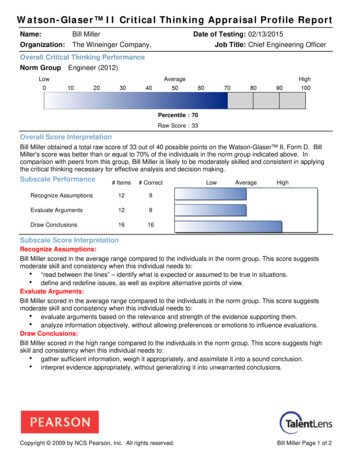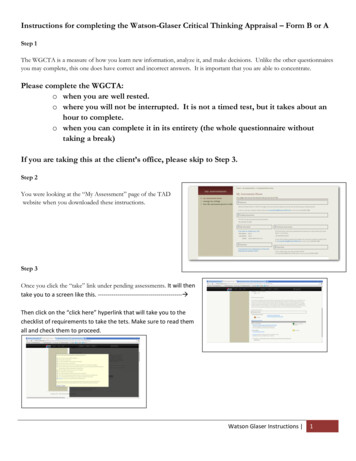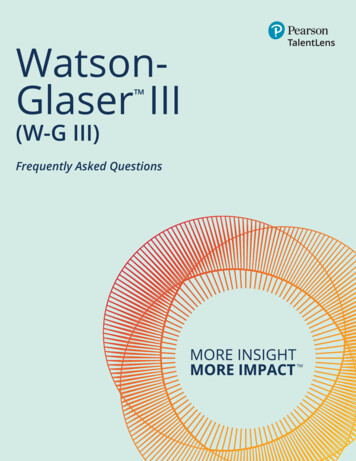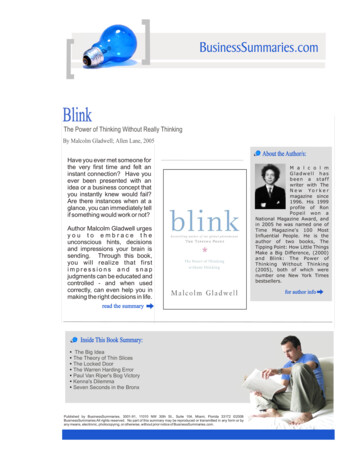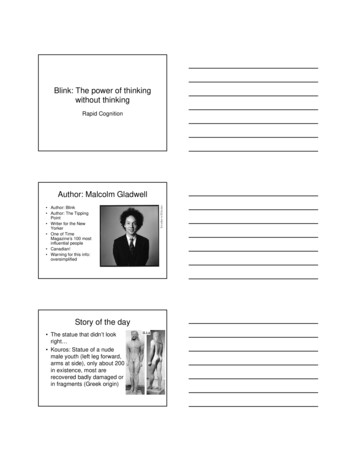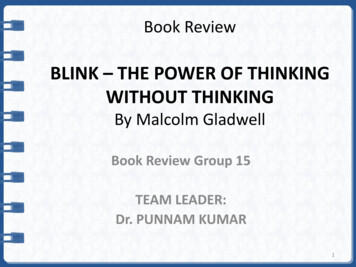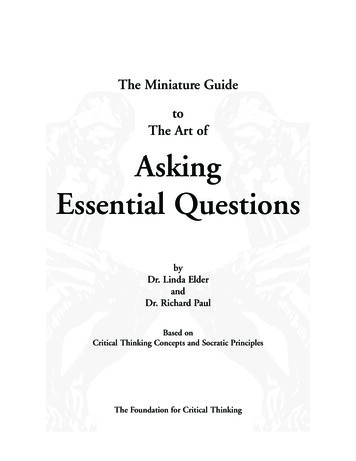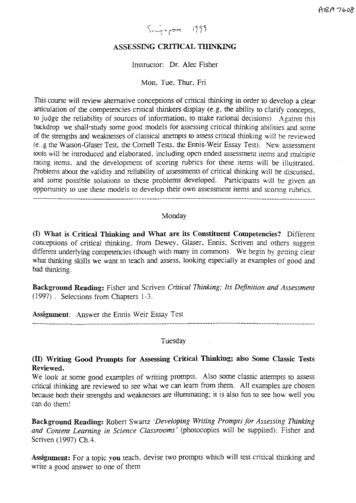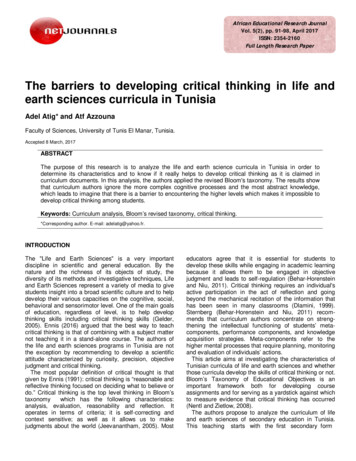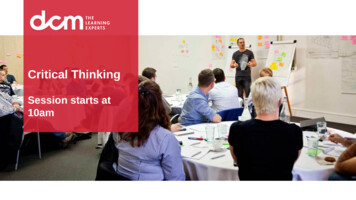
Transcription
1Watson-GlaserCritical ThinkingAppraisal III (WG-III)E NTE RA S S E S S ME NT E FFIC AC Y R E PORT — APRIL 2020
IntroductionAbout efficacyreporting at PearsonExecutive summaryContentsHow did evidence informthe design of Watson-Glaser?What does the evidence sayabout Watson-Glaser?Watson-Glaser in actionDiscussionReferences
3IntroductionIntroduction – About efficacy reporting at Pearson – Executive Summary – How did evidence inform the design of Watson-Glaser? – What does the evidence say about Watson-Glaser? – Watson-Glaser in action – Discussion – References
In 2013, we were the first company to make a commitmentto measure our impact on some of the outcomes that mattermost such as academic achievement. But there was no rulebook and no model to follow. We’ve had to carve our ownpath to define what efficacy looks like in education.While our approach is rigorous, the concept underlying it is simple:we use evidence and research to design products and solutions tohelp individuals achieve the outcomes that matter to them. Then,we measure the impact of using our products, report that impact ina transparent way, and use what we learn to help individuals – andourselves – continuously improve.Today, we are taking what we have learned and evolving our approach.We are focusing more on designing products to have a measurableimpact, not just during education, but on employability and lifelonglearning as well.We want our commitment to efficacy to be a reason for individualsto believe in Pearson, to see us as their trusted guide to lifelonglearning, as they navigate a changing world of work. Skills that arehard to automate, like communication and critical thinking, are inmore demand than ever. And now that the idea of a job for life isgone, people need to continuously grow, demonstrate theirskills and adapt their talent.People need a lifetime of learning and so we must refocusand redesign learning. The way we learn needs to support thedevelopment of the key skills people need to thrive today andin the future.Introduction – About efficacy reporting at Pearson – Executive Summary – How did evidence inform the design of Watson-Glaser? – What does the evidence say about Watson-Glaser? – Watson-Glaser in action – Discussion – References
Efficacy in 2020A critical segment of Pearson’s portfolio is its Assessment business. This report on theWatson-Glaser Critical Thinking Appraisal is part of our ongoing commitment to communicateabout our impact in a transparent way for our assessment offerings. Watson-Glaser measuresa person’s critical thinking skills -- their ability to question assumptions, objectively evaluateinformation and arguments, and make logical and well-informed decisions.Our commitment to efficacy is on-going and all our 2020 efficacy reports are available onpearson.com/news-and-research/efficacySpecial thanksWe want to thank all the customers, test-takers, researchinstitutions and organizations we have collaborated with to date. Ifyou are interested in partnering with us on future efficacy research,have feedback or suggestions for how we can improve, or want todiscuss your approach to using or researching our assessments,we would love to hear from you at efficacy@pearson.com.Kate Edwards, PhDSVP Efficacy & LearningPearsonIntroduction – About efficacy reporting at Pearson – Executive Summary – How did evidence inform the design of Watson-Glaser? – What does the evidence say about Watson-Glaser? – Watson-Glaser in action – Discussion – References5
6Learn more about theprocesses and principlesfor efficacy hereAbout efficacyreporting atPearsonIntroduction – About efficacy reporting at Pearson – Executive Summary – How did evidence inform the design of Watson-Glaser? – What does the evidence say about Watson-Glaser? – Watson-Glaser in action – Discussion – References
As part of our commitment to being open and transparent about howwe design, develop, and evaluate the impact of use of our productson learning, we produce a range of efficacy publications, includingreports and guides. This report is one of our Assessment Reports.Technical Research Reports 1 – 2 – 4These describe a single piece of impact evaluationresearch into the use of a product, undertaken tomeet the standards expected for publication in apeer-reviewed academic journal. Selected statementsin our Technical Research Reports are independentlyassured by Pricewaterhouse Coopers (PwC).Product Guides 3 – 4These explain what the evidence about a singleproduct means for users of that product. ProductGuides combine research findings with stories fromreal users to help you replicate best practice with theproduct and achieve the best outcomes for learners.Assessment Reports 3 – 5These summarize the evidence about a singleassessment’s capability to measure a trait or abilityin a valid, reliable and fair manner, These reportsare not independently assured, because we donot expect assessments to have a direct effecton outcomes for individuals.Product Efficacy Reports 1 – 3 – 4These summarise all the relevant impact evaluationresearch related to the use of a single product.This includes research described in TechnicalResearch Reports and learning research thatinformed the product’s design and use. Selectedstatements in our Product Efficacy Reports areindependently assured by PwC.Qualification & Certification Reports 3 – 5These reports include information about howthe design of the qualification or certificationwas informed by research. They bring in evidenceabout how the qualification is delivered, and how itsupports experience and progression. It summarizesrelevant Technical Research Reports associatedwith the assessment of the qualification and impactevaluation research related to learner outcomes.Key1– Independently assured by PwC2– Details a single study3– Summarizes all relevant evidence4– Evaluates impact on learner outcomes5–E valuates assessment quality indicators:validity, reliability, and fairness7Introduction – About efficacy reporting at Pearson – Executive Summary – How did evidence inform the design of Watson-Glaser? – What does the evidence say about Watson-Glaser? – Watson-Glaser in action – Discussion – References
8Efficacy and assessmentsUsually when we talk about the efficacy of a product, we mean the impactof its use on outcomes for individuals, like achievement and progression.Assessments are a little different. Taking a test may not be a learningexperience in itself, but test results can be used to make decisions aboutan individual, such as readiness for an educational program or suitabilityfor a job. So the efficacy of an assessment is the extent to which itprovides an accurate snapshot of what an individual knows and can do.ValidityValidity depends on evidence that the assessment is suitable for aspecific intended purpose, and that we can interpret the results asintended. Validity is always context-sensitive; we cannot say that anassessment is or is not valid, period, only that it is or is not validfor a particular purpose.ReliabilityReliability depends on evidence that the results stay consistent overtime, over multiple forms of the assessment, and/or over multiple scorers.We judge the efficacy of assessments like Watson-Glaser against threeAssessment Quality Indicators (AQIs): validity, reliability, and fairness.These factors help us evaluate if the assessment gives an accuratepicture of the individual's knowledge and capabilities.FairnessFairness depends on evidence that the results mean the same thing forall intended test-takers. This means it is not systematically biased againstany group of test-takers and the way it is administered does not hinderany test-takers in demonstrating their ability in the area being assessed.Our AQIs are based on attributes defined in the Standards for Educationaland Psychological Testing, developed in 2014 by the American EducationalResearch Association (AERA), the American Psychological Association (APA),and the National Council on Measurement in Education (NCME). Thesestandards have long been recognized as best practice for both developingand evaluating assessments, and play a role in legal defences of assessment.Introduction – About efficacy reporting at Pearson – Executive Summary – How did evidence inform the design of Watson-Glaser? – What does the evidence say about Watson-Glaser? – Watson-Glaser in action – Discussion – References
9ExecutiveSummaryIntroduction – About efficacy reporting at Pearson – Executive Summary – How did evidence inform the design of Watson-Glaser? – What does the evidence say about Watson-Glaser? – Watson-Glaser in action – Discussion – References
10Executive summaryCritical thinking skills are essential for success in education and theworkplace. Mentions of critical thinking as a requirement in job postingsin the United States more than doubled between 2009 and 2014 (Korn,2014). For many, the purpose of earning a post-secondary degree isto learn the knowledge and skills, like critical thinking, to demonstratethey are qualified for employment. Recognizing this, 92% of teachersin an international survey identified critical thinking as one of the mostimportant skills needed for success in higher education (Stewart, 2014).In addition, the way an assessment is implemented has as muchinfluence on its efficacy as its design, so we also interviewed customersto investigate how they are using Watson-Glaser in real situations.The Watson-Glaser Critical Thinking Appraisal is a verbal ability testmeasuring critical thinking ability. It assesses an individual’s abilityto analyze, interpret, and draw logical conclusions from writteninformation — critical thinking skills. It addresses the challengesof higher education professionals, HR professionals and employersby giving them the means to measure critical thinking ability as afirst step toward supporting its development." Watson Glaser proves to them thatthey can become better thinkers".“ We have made it part of the campusculture . this is what we do here”.How the University of South Florida uses Watson-GlaserHow the US Air Force uses Watson-GlaserVisit the product website: tThe structure of the Watson-Glaser assessment and its scoring wasinformed by the RED model, which breaks critical thinking down intothe ability to recognize assumptions, evaluate arguments, and drawconclusions. This report summarizes the studies that demonstrate thevalidity, reliability and fairness of the test in measuring critical thinking.Introduction – About efficacy reporting at Pearson – Executive Summary – How did evidence inform the design of Watson-Glaser? – What does the evidence say about Watson-Glaser? – Watson-Glaser in action – Discussion – References
11How did evidenceinform the designof Watson-Glaser?Introduction – About efficacy reporting at Pearson – Executive Summary – How did evidence inform the design of Watson-Glaser? – What does the evidence say about Watson-Glaser? – Watson-Glaser in action – Discussion – References
The Watson-Glaser Critical Thinking Appraisalis a verbal ability test measuring critical thinkingability. It assesses an individual’s ability to analyze,interpret, and draw logical conclusions fromwritten information.12In this section1 T he importance ofcritical thinking2 T he RED model3 O ver-exposure4 Biases5 Norms6 H istory and reachof Watson-GlaserThis ability is a crucial stepping stone to logical thinking, decisionmaking, and problem-solving, all of which are essential not just foracademic and career success, but for becoming a positive participantin our society. Thousands of employers, colleges and schools aroundthe world use Watson-Glaser to identify great employees to hire andhigh potential employees to develop, and to choose which studentsto admit into challenging programs.Watson-Glaser presents test-takers with a series of passages orscenarios, each of which is accompanied by a number of items forthem to respond to. The test is completed online, and is suitable forboth supervised and unsupervised administration. Most versions ofthe test are timed, though the recommended time limit is intentionallygenerous. There is also an optional follow-up interview component,which administrators can use to gain more insight into the raw testscores. Pearson also offers professional development support for thepeople responsible for interpreting and taking action based on theassessment results.Organizations use Watson-Glaser scores to select and developemployees for roles that require careful analysis, logical decisionmaking and problem solving, and to predict employees’ performancein these roles. In academic settings, Watson-Glaser is used to selectstudents for particular courses.Our own studies show that Watson-Glaser scores correlate highlywith course grades in a number of undergraduate courses (Watson &Glaser, 2019). However, the main application of Watson-Glaser is as atool for assessing potential employees before making hiring decisions.Introduction – About efficacy reporting at Pearson – Executive Summary – How did evidence inform the design of Watson-Glaser? – What does the evidence say about Watson-Glaser? – Watson-Glaser in action – Discussion – References
13The importance of critical thinking95%In this section1 T he importance ofcritical thinking2 T he RED model3 O ver-exposure4 Biases5 Norms6 H istory and reachof Watson-GlaserCritical thinking is what allows us to tellreliable sources from disinformationand allows us to form our own opinionsbased on the things we read. It’s whatallows us to make and justify good, fullyinformed decisions. It is the essentialskill for the information age.There is a wealth of research and literature oncritical thinking and how to define it. According tothis body of research, at its core, critical thinkingentails questioning assumptions, objectivelyevaluating information and arguments, andmaking logical and
The structure of the Watson-Glaser assessment and its scoring was informed by the RED model, which breaks critical thinking down into the ability to recognize assumptions, evaluate arguments, and draw conclusions. This report summarizes the studies that demonstrate the validity, reliability and fairness of the test in measuring critical thinking.
